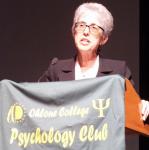On the evening of Friday, October 12th, the Ohlone Psychology  Dr. Carol TavrisClub Speaker Series continued its three-year tradition of providing top-name speakers in science and skepticism by hosting renowned social psychologist Dr. Carol Tavris.
Dr. Carol TavrisClub Speaker Series continued its three-year tradition of providing top-name speakers in science and skepticism by hosting renowned social psychologist Dr. Carol Tavris.
Dr. Tavris’ talk was based upon her book “Mistakes Were Made (but not by me)” which she co-wrote with Elliot Aronson. The book focuses on cognitive dissonance, a psychological phenomenon in which we feel uncomfortable due to conflicting behaviors, opinions, thoughts, or beliefs. Coined by Leon Festinger, one of the true geniuses in the field of psychology, the influence of cognitive dissonance on our behavior is one of the most powerful, yet least recognized, phenomena.
Festinger’s now-classic 1956 book, “When Prophecy Fails,” brought the term cognitive dissonance into the modern lexicon. After seeing the newspaper headline, “Prophecy from planet Clarion call to city: flee that flood,” he and his colleagues couldn’t resist investigating the doomsday cult described by the article. Dorothy Martin, a housewife from Chicago (who had recently left the Scientology movement) began to experiment with automatic writing. After relocating to Michigan, she quickly gained a following of committed believers whom she convinced that the messages she was receiving through paranormal means were real. The group eventually culminated into a full-blown cult who believed that our planet was doomed, and that only the true believers in their group would be rescued by the arrival of a race of aliens in a flying saucer from the planet Clarion.
True to his predictions, Festinger found that many of the most committed followers (who had given up their jobs, turned over all of their money and belongings, cut off ties with family and other outsiders, etc.) stayed on even after the prophecy failed to come true. In fact, the more committed the group member (by word, as well as by deed), the more likely she or he was to remain. Festinger called the driving force behind this phenomenon cognitive dissonance, and explained that we are driven to reduce the discomfort (dissonance) by such means as altering memory, twisting logic, outright denial, or pseudo-apologetics.
As one of Festinger’s doctoral students and a mentee, Aronson refined the theory of cognitive dissonance, adding that it was not purely cognitive, but also emotional. In her talk, Dr. Tavris detailed this history, and provided numerous examples of cognitive dissonance from everyday life.
For instance, during the buildup to the 2002 invasion of Iraq by U.S. military forces, Bush Administration officials and the president himself repeatedly asserted that sufficient intelligence existed to suggest that Iraq was building nuclear weapons, in direct violation of U.N. Security Council resolutions. After the invasion, when no such weapons were found, these officials did not, as would seem logical, then announce that they had been wrong. Instead, they publicly stated (contrary to the evidence in plain view) that we had found such weapons. After much media scrutiny, they then began to insist that, although no weapons were found, they had found evidence that weapons programs existed. After those allegations were proven false, the administration eventually shifted the discussion to having succeeded in removing a dangerous, despotic leader. Therefore, similar to the followers of Dorothy Martin’s cult members, politicians and pundits avoided cognitive dissonance by unconsciously twisting reality, and by altering their memories of their behaviors. Similarly, when pressed to answer for their role in the decision to go to war, Democrats who had voted in favor of the invasion conveniently forgot that they had supported it, and began telling reporters and others that they had been against the invasion from the start.
As Dr. Tavris reminded us several times throughout the evening, it is important to realize that, although exceptions do exist, most of these were good, honest, trustworthy, loyal people. However, when any of us is presented with evidence that suggests we might have done something bad, dishonest, untrustworthy, or disloyal, the person who accepts that reality is rare, indeed. It is far more likely that she or he will avoid dissonance by other means.
In her talk (as in her book), Dr. Tavris provided entertaining and provocative examples such as this, always careful to remind us that no one is immune to the phenomenon. On rare occasions, however, we have born witness to inspiring examples of facing the truth of such contradictions. One of my favorites involves former U.S. president Ronald Reagan, and his longtime friend, Israeli president Shimon Peres. When asked by a reporter how he now felt about his friend [Reagan] after a seemingly anti-Israeli statement he had made, Peres wisely answered, “When a friend makes a mistake, the mistake remains a mistake, and the friend remains a friend.”
We should all be so insightful. To listen to Carol Tavris explain this herself, check out her For Good Reason interview with our friend D.J. Grothe.
